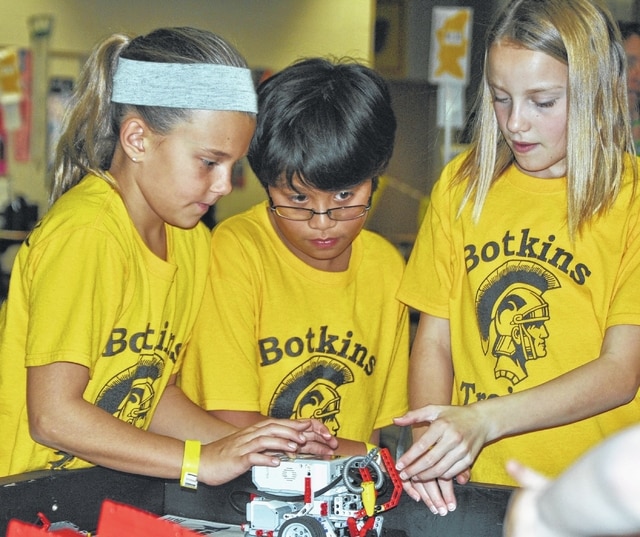
BELLEFONTAINE — This past Saturday, a half-dozen engineers-slash-programmers were hunched in a semi-circle, almost desperate to correct a problem with a robot that was designed, programmed, and hand-built by these same engineers.
The robot had the critically important job of picking up solid waste from one point and transporting it to another, but it wasn’t cooperating, missing the pick-up point again and again. After some tense moments and a thunderclap of brainstorms, an adjustment or two was made to both the robot and the programing and mission was restarted. No breaths were taken for the 10 or so seconds while the robot made its rounds. This time the robot performed perfectly, to audible sighs and general elation of those gathered round to watch.
What made this scene remarkable was that it did not take place in Silicon Valley or the inner recesses of a NASA lab. The event took Benjamin Logan Middle School campus in Logan County and all of the aforementioned designers, programmers, and engineers are Botkins students ranging in age from 12 to 14.
It’s part of a competition called the First Lego League (FLL) and with the support and encouragement of Lego and others – especially Honda in western Ohio – middle schoolers across the nation are building and maintaining robots that are capable of completing the trickiest of tasks, all on a Lego-sized scale.
This season, the FLL has focused on rubbish, hence the theme of the 2015 FLL Challenge which is Trash Trek. The FLL designed a sequence of 12 tasks that the student-designed robots must perform, all of which this season involved the handling or sorting of waste materials, albeit with Legos on a surface the size of a standard billiard table.
Basically, the students are handed a box full of small servos and Legos, given table-sized floor plan of a factory or manufacturing facility, assigned the 12 tasks to have their robots perform on the floor plan and told to get after it. Some assembly required.
The phrase “student-designed” is not an empty one. It is they who are responsible for building the entire complex from the ground up, or in this case, the box out. Students run the show for the entire process, from soup to nuts. The FLL competition calls on the students to give their executive function a workout by having them to design, program, engineer, present and display their work (which is also part of the FLL competition), work in teams, problem solve, think critically, network, the list goes on.
Rob Berryman, an employee of the Midwest Regional ESC, was assigned to help mentor the RoBotkins squad this fall, but Botkins has been competing in the FLL for years, so Berryman basically sits back and watches the kids work.
“They do amazing things,” Berryman said of his charges as they geared up their robot for yet another task. “They think differently than I do, and come up with solutions to problems that I wouldn’t even consider.”
This is a real-deal competition and these clubs are out to earn the hardware. Most – but not all – of the clubs are supported and encouraged by local schools, as is the RoBotkins team. They were given plenty of tune-up time on the various practice tables in the morning, but the heat of battle took place on two immaculate FLL tables set up in the BLMS gym which were strictly off-limits to everybody (even nosy reporters) until the completion began. Once a team places its robot on one of the competition tables, it’s hands-off and that is when the real pressure begins. The robots are given points based on the percentage of a certain task the robot is able to perform, ‘x’ amount of points 30 percent completion, additional points for 50 percent and so on.
When asked which one of the 12 tasks was the hardest to program and complete, every last team, without hesitation, said “methane”, a task involving removing the gas from landfills and moving it to where it could be converted into energy. Another task included the demolition of a building, then sorting through the rubble for waste and recyclables.
It is small wonder that companies such as Honda go out of their way to help out with the FLL. These middle-schoolers are building scale-models of the very same same robots that are in use in Honda (and other) plants in Anna, East Liberty, Marysville, and Russells Point, indeed, all over the world. Ten years from now, Honda is going to need highly-skilled workers who can design, program, engineer, and repair robotics. What better place to start than right outside the front door.
Not that anyone has to push these kids into playing with Legos.


